Text

Some sketches of Triassic stem-crocodiles (Prestosuchus chiniquensis and Saurosuchus galilei)
#prestosuchus#saurosuchus#pseudosuchian#rauisuchian#(if you like outdated taxonomy)#crocodile#(stem-line that is)#archosaur#reptile#vertebrate#triassic#mesozoic#paleontology#palaeoblr#paleoart#my art
18 notes
·
View notes
Text

Modelled some brachiopods (unidentified lingulid and discinid) the other day as part of a larger commission. I think they came out pretty nicely.
#colors boldly copied from living representatives of their respective groups#im a daring paleoartist like that#lingulid#discinid#brachiopod#mesozoic#paleontology#palaeoblr#paleoart#my art
31 notes
·
View notes
Text
I haven't posted in a while because I've been busy with some big commissions but here's a low-quality little guy I made as a secondary element of one of said commissions (generalized conodont):
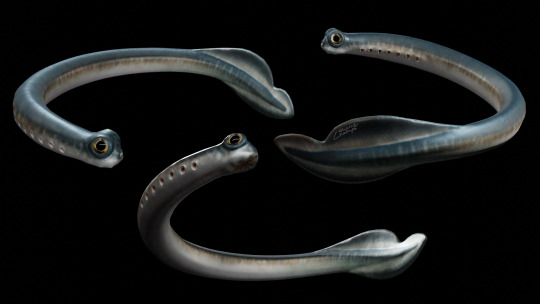
References and notes:
Following the "standard" for conodont reconstructions, morphology is based on the 3 species with known soft tissues (Clydagnathus windsorensis, Panderodus unicostatus, and the giant Promissum pulchrum) (Aldridge et al. 1986, Gabbott et al. 1995, Murdock & Smith 2021), with details filled in from living hagfish and lampreys based on the assumed vertebrate (and possibly even cyclostome) affinity of conodonts (Miyashita et al. 2019). The count of 7 pairs of gill openings (as in lampreys) is simply because i couldn't be bothered to sculpt more.
Note that the mouth is not depicted as a the usual gaping hole filled with spiny elements but rather as folded tissues nicely hiding any trace of offensive toothiness, much like modern hagfish, which, despite their impressive set of "teeth", have a very kissable (closed) mouth. I understand the didactic value of showing the element apparatus in conodont reconstructions but have always felt a little weird about depicting animals actually swimming around looking like that... but who knows?
Another departure from the usual way of reconstructing conodonts is the inclusion of a single nostril. This is based on the single nostril of extant hagfish and lamprey (to which (eu-)conodonts may be most closely related to) (Miyashita et al. 2019), and also supported by the fact that a single nostril may be part of the ancestral state of vertebrates (Oisi et al. 2013) (assuming conodonts are actually vertebrates, of course).
Anyway, that was a lot of reading and shoddy speculation for a background model. Certainly don't trust any of it, I don't know shit about conodonts.
References:
Aldridge, R. J., Briggs, D. E. G., Clarkson, E. N. K., & Smith, M. P. (1986). The affinities of conodonts—New evidence from the Carboniferous of Edinburgh, Scotland. Lethaia, 19(4), 279–291. https://doi.org/10.1111/j.1502-3931.1986.tb00741.x
Gabbott, S. E., Aldridge, R. J., & Theron, J. N. (1995). A giant conodont with preserved muscle tissue from the Upper Ordovician of South Africa. Nature, 374(6525), 800–803. https://doi.org/10.1038/374800a0
Miyashita, T., Coates, M. I., Farrar, R., Larson, P., Manning, P. L., Wogelius, R. A., Edwards, N. P., Anné, J., Bergmann, U., Palmer, A. R., & Currie, P. J. (2019). Hagfish from the Cretaceous Tethys Sea and a reconciliation of the morphological–molecular conflict in early vertebrate phylogeny. Proceedings of the National Academy of Sciences of the United States of America, 116(6), 2146–2151. https://doi.org/10.1073/pnas.1814794116
Murdock, D. J. E., & Smith, M. P. (2021). Panderodus from the Waukesha Lagerstätte of Wisconsin, USA: A primitive macrophagous vertebrate predator. Papers in Palaeontology, 7(4), 1977–1993. https://doi.org/10.1002/spp2.1389
Oisi, Y., Ota, K. G., Kuraku, S., Fujimoto, S., & Kuratani, S. (2013). Craniofacial development of hagfishes and the evolution of vertebrates. Nature, 493(7431), 175–180. https://doi.org/10.1038/nature11794
#dubious speculation#<- i'll be using that tag in the future for reconstructions involving disputable or unsupported personal takes (see notes under the cut)#also no fine attention given to anatomy and proportions for this one#probably don't use it as a reference for anything#conodont#chordate#paleozoic#paleontology#paleoart#palaeoblr#my art
30 notes
·
View notes
Text
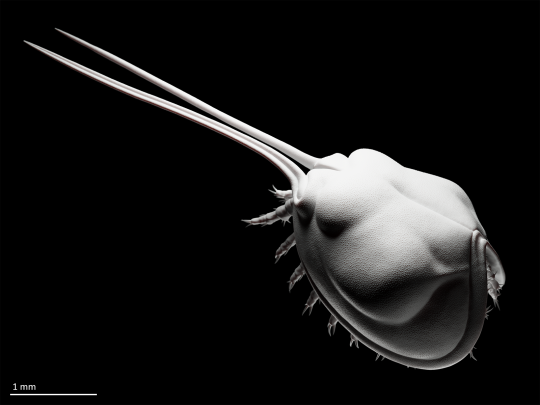
Sculpt of the small bivalved arthropod Gladioscutum lauriei from the middle Cambrian of Australia (after Hinz-Schallreuter & Jones 1994).
Gladioscutum had a body only 2-3 mm long, but, being undoubtedly aware of its disappointingly small size compared to its cooler Cambrian cousins like radiodonts and trilobites, tried to make up for it with a pair of (presumably) front-facing spines that were at least as long as the rest of the head shield.
Other than improving its self-esteem, the function of Gladioscutum's extremely elongated spines is unknown. The enlarged spines of other small Cambrian bivalved arthropods have been suggested to fulfill a sensory role, but this remains speculative (Zhang et al. 2014).
References and notes:
Gladioscutum was originally described as an "archaeocopid", an order that is now known to be an artificial grouping of various small bivalved arthropod fossils superficially resembling modern ostracod crustaceans. To my knowledge, the affinities of Gladioscutum have not been reinvestigated since its initial description, but its appearance (marginal rims, valve lobation, ornamented surface, simple hinge line) and age seem bradoriid-y enough (Hou et al. 2001) for me to more or less confidently reconstruct it as one (top scientific rigour as always on this blog).
Appendage morphology is unknown in Gladioscutum - what little soft anatomy I have not modestly hidden under the head hield is based on the bradoriid Indiana sp. from the Chengjiang Biota (Zhai et al. 2019). In that species, only the antennae are differentiated from the rest of the appendages, which has the double advantage of (1) not making crazy hypotheses about limb specialization in Gladioscutum and (2) giving me fewer different types of limbs to sculpt.
Like Gladioscutum, most bradoriids are only known from their decay-resistant valves, which are often squashed flat in a so-called "butterfly" position. This arrangement has been traditionally interpreted as the life position of the animals, which were implied to crawl over the seafloor like tiny crabs (e.g., Hou et al. 1996). Yet, undistorted fossils of head shields preserved in 3D are almost always closely drawn together, which is similar to the way modern bivalved arthropods like ostracods are articulated (protecting the soft limbs and body) and probably more reflective of the actual life position of bradoriids (Betts et al. 2016), as depicted here.
References:
Betts, M. J., Brock, G. A., & Paterson, J. R. (2016). Butterflies of the Cambrian benthos? Shield position in bradoriid arthropods. Lethaia, 49(4), 478–491. https://doi.org/10.1111/let.12160
Hinz-Schallreuter, I., & Jones, P. J. (1994). Gladioscutum lauriei n.gen. N.sp. (Archaeocopida) from the Middle Cambrian of the Georgina Basin, central Australia. Paläontologische Zeitschrift, 68(3), 361–375. https://doi.org/10.1007/BF02991349
Hou, X., Siveter, D. J., Williams, M., Walossek, D., & Bergström, J. (1997). Appendages of the arthropod Kunmingella from the early Cambrian of China: Its bearing on the systematic position of the Bradoriida and the fossil record of the Ostracoda. Philosophical Transactions of the Royal Society of London. Series B: Biological Sciences, 351(1344), 1131–1145. https://doi.org/10.1098/rstb.1996.0098
Hou, X., Siveter, D. J., Williams, M., & Xiang-hong, F. (2001). A monograph of the Bradoriid arthropods from the Lower Cambrian of SW China. Earth and Environmental Science Transactions of The Royal Society of Edinburgh, 92(3), 347–409. https://doi.org/10.1017/S0263593300000286
Zhai, D., Williams, M., Siveter, D. J., Harvey, T. H. P., Sansom, R. S., Gabbott, S. E., Siveter, D. J., Ma, X., Zhou, R., Liu, Y., & Hou, X. (2019). Variation in appendages in early Cambrian bradoriids reveals a wide range of body plans in stem-euarthropods. Communications Biology, 2(1), Article 1. https://doi.org/10.1038/s42003-019-0573-5
Zhang, H., Dong, X., & Xiao, S. (2014). New Bivalved Arthropods from the Cambrian (Series 3, Drumian Stage) of Western Hunan, South China. Acta Geologica Sinica - English Edition, 88(5), 1388–1396. https://doi.org/10.1111/1755-6724.12306
#i'll probably make more art of cambrian bivalved arthropods with fucked up spines#because there is no shortage of them#and they still manage to all look rather distinct#gladioscutum#bradoriid#(?)#arthropod#cambrian#paleozoic#australia#paleontology#palaeoblr#paleoart#my art
39 notes
·
View notes
Text

Falcatamacaris bellua is not, as it may seem at first glance, a fictive trilobite designed by a 6-year old, but a large (~10 cm) arthropod from the Weeks Formation (early Cambrian) notably distinguished by curved pleural spines (giving it its name*), a weakly biomineralized cuticle, and an unwillingness to be classified precisely.
Bonus views of the quick 3D model I made as a drawing reference:
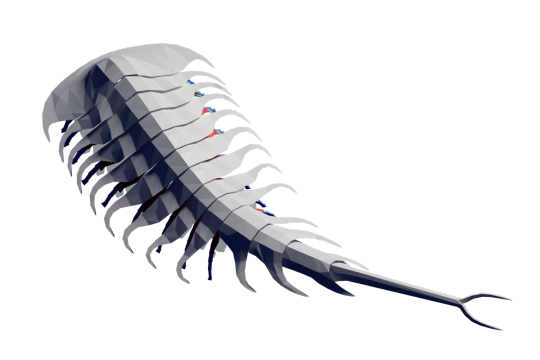

References and notes:
*name which, by the way, is based on an incorrect use of the latin falcatus,-a,-um in its unexplainably inflected form falcatam, which exasperates me disproportionately (name should be Falcatacaris (how did the reviewers not give them shit for that mistake?)) (i am experiencing several taxonomy-related annoyances these days (perhaps i just need something inconsequential on which to take out my anger (anyway))).
Available fossil material of Falcatamacaris only features the dorsal carapace along with limited evidence for 3 cephalic pairs of limbs (but apparently no antennae) (Ortega-Hernández et al. 2015). The walking appendage morphology and arrangement depicted here is therefore only speculative and based on a generalized artiopodan (a broad group including trilobites and friends, within which Falcatamacaris has an uncertain position), after Sein & Selden (2012).
References:
Ortega-Hernández, J., Lerosey-Aubril, R., Kier, C., & Bonino, E. (2015). A rare non-trilobite artiopodan from the Guzhangian (Cambrian Series 3) Weeks Formation Konservat-Lagerstätte in Utah, USA. Palaeontology, 58(2), 265–276. https://doi.org/10.1111/pala.12136
Stein, M., & Selden, P. A. (2012). A restudy of the Burgess Shale (Cambrian) arthropod Emeraldella brocki and reassessment of its affinities. Journal of Systematic Palaeontology, 10(2), 361–383. https://doi.org/10.1080/14772019.2011.566634
#mild taxonomic pissiness#just another Junnn11-inspired piece before getting back to serious business#as a treat#falcatamacaris#artiopod#arthropod#cambrian#paleozoic#paleontology#palaeoblr#paleoart#my art
51 notes
·
View notes
Text
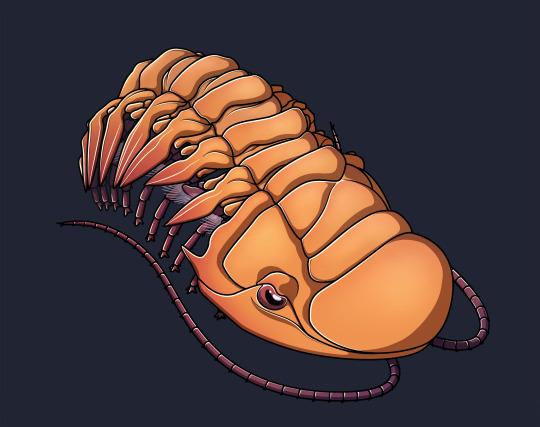
The Devonian trilobite Crotalocephalina gibba.
Made as a more or less successful exercise to emulate the style of Junnn11, the person who illustrated many of the wikipedia articles on Cambrian arthropods and Paleozoic euchelicerates (and whose art I happen to like very much).
#very accidental lesbian color scheme#i swear i didn't do it on purpose the colors just looked nice#i only realized two hours after picking the colors and went with it#it's not my fault if lesbians have the best pride flag#(perhaps with the exception of the aro and aroace ones - but there certainly is no reason for my opinion on these to biased hehe)#anyway#drawing based on a fossil i have on my desk#minus the appendages of course (those are mainly adapted from Ceraurus pleurexanthemus)#because there's no way on earth i'm drawing a cheirurid in a non-neutral pose with just my imagination and a few top view photos/diagrams#all these furrows and little knobs around the articulations!!!#also heeeeeyy i'm not dead i'm still making art#between work travel and the fact that i've started sketching on paper again over the last 6 months#i haven't done much digital art worth posting#(still hesitating to post my paper sketches on here)#but i do have some cool 3d projects in the works#so i will probably be posting some pieces in my usual style in the more or less near future#crotalocephalina#cheirurid#trilobite#arthropod#devonian#paleozoic#paleontology#palaeoblr#paleoart#my art
20 notes
·
View notes
Text


Europasaurus holgeri, a macronarian sauropod from the Late Jurassic of Germany, most famous for its unusually small size (just over 6 m long for mature specimens) attributed to insular dwarfism.
(Repost of some older 2022 art from my general-purpose blog, with additional renders and a proper bibliography)
References:
Marpmann, J. S., Carballido, J. L., Sander, P. M., & Knötschke, N. (2015). Cranial anatomy of the Late Jurassic dwarf sauropod Europasaurus holgeri (Dinosauria, Camarasauromorpha): Ontogenetic changes and size dimorphism. Journal of Systematic Palaeontology, 13(3), 221–263. https://doi.org/10.1080/14772019.2013.875074
Martin Sander, P., Mateus, O., Laven, T., & Knötschke, N. (2006). Bone histology indicates insular dwarfism in a new Late Jurassic sauropod dinosaur. Nature, 441(7094), Article 7094. https://doi.org/10.1038/nature04633
#europasaurus#macronaria#sauropod#dinosaur#reptile#vertebrate#jurassic#mesozoic#paleontology#palaeoblr#paleoart#my art
38 notes
·
View notes
Text

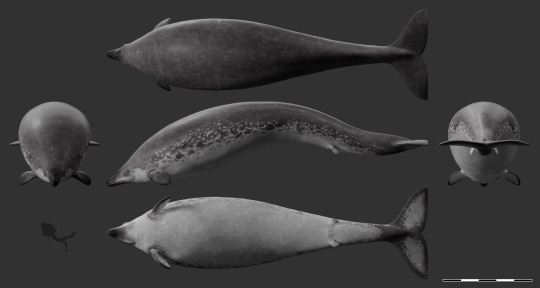
The archeocete Perucetus colossus dives through a coastal bloom of jellyfish in the Pisco Basin (southern Peru), some time during the Eocene (with bonus multiview).
I originally intended to add epibionts to this reconstruction (reflecting the specialized communities found on many living whales, especially baleen whales). Yet, interestingly, it appears that most animal epibionts and ectoparasites of modern cetaceans, such as whale barnacles (Hayashi et al. 2013) and remoras (Friedman et al. 2013), only appeared in the Neogene or late Paleogene, or have a poorly known (co-)evolutionary history, like whale lice (Pfeiffer 2009, Iwasa-Arai & Serejo 2018) and pennellids (large parasitic copepods) (Hermosilla et al. 2015). So, no epibionts* for big lad Perucetus!
References and notes about the reconstruction:
*animal epibionts. Unicellular eukaryotes like diatoms were most likely present on early cetaceans, given their prevalence on modern large marine animals (Ashworth et al. 2022). Of course, it is possible that other animals (i.e., early, less specialized representatives of modern groups, or different taxa altogether) were also already exploiting the surfaces offered by these early whales; however, this remains entirely speculative.
The reconstruction of Perucetus proposed in its original description (Bianucci et al. 2023) includes some rather odd (if interesting) choices about soft tissues, including limbs with webbed and distinguishable fingers, and a manatee-like tail. While these choices might be defendable in light of the rather basal status of Perucetus among cetaceans, I opted for a more derived look based on the assumption that fully marine cetaceans like basilosaurids would have probably rapidly acquired hydrodynamically favorable adaptations, pushing them towards a more familiar Neoceti-like appearance (even though Perucetus itself was likely a poor swimmer (Bianucci et al. 2023), it seems likely to me that this was a secondarily acquired trait, given the less extreme morphology of other basilosaurids).
Reconstruction in the multiview scaled to ~18 m in length after the estimations of Bianucci et al. (2023).
References:
Ashworth, M. P., Majewska, R., Frankovich, T. A., Sullivan, M., Bosak, S., Filek, K., Van de Vijver, B., Arendt, M., Schwenter, J., Nel, R., Robinson, N. J., Gary, M. P., Theriot, E. C., Stacy, N. I., Lam, D. W., Perrault, J. R., Manire, C. A., & Manning, S. R. (2022). Cultivating epizoic diatoms provides insights into the evolution and ecology of both epibionts and hosts. Scientific Reports, 12(1), Article 1. https://doi.org/10.1038/s41598-022-19064-0
Bianucci, G., Lambert, O., Urbina, M., Merella, M., Collareta, A., Bennion, R., Salas-Gismondi, R., Benites-Palomino, A., Post, K., de Muizon, C., Bosio, G., Di Celma, C., Malinverno, E., Pierantoni, P. P., Villa, I. M., & Amson, E. (2023). A heavyweight early whale pushes the boundaries of vertebrate morphology. Nature, 620(7975), Article 7975. https://doi.org/10.1038/s41586-023-06381-1
Friedman, M., Johanson, Z., Harrington, R. C., Near, T. J., & Graham, M. R. (2013). An early fossil remora (Echeneoidea) reveals the evolutionary assembly of the adhesion disc. Proceedings of the Royal Society B: Biological Sciences, 280(1766), 20131200. https://doi.org/10.1098/rspb.2013.1200
Hayashi, R., Chan, B. K. K., Simon-Blecher, N., Watanabe, H., Guy-Haim, T., Yonezawa, T., Levy, Y., Shuto, T., & Achituv, Y. (2013). Phylogenetic position and evolutionary history of the turtle and whale barnacles (Cirripedia: Balanomorpha: Coronuloidea). Molecular Phylogenetics and Evolution, 67(1), 9–14. https://doi.org/10.1016/j.ympev.2012.12.018
Hermosilla, C., Silva, L. M. R., Prieto, R., Kleinertz, S., Taubert, A., & Silva, M. A. (2015). Endo- and ectoparasites of large whales (Cetartiodactyla: Balaenopteridae, Physeteridae): Overcoming difficulties in obtaining appropriate samples by non- and minimally-invasive methods. International Journal for Parasitology: Parasites and Wildlife, 4(3), 414–420. https://doi.org/10.1016/j.ijppaw.2015.11.002
Pfeiffer, C. J. (2009). Whale Lice. In W. F. Perrin, B. Würsig, & J. G. M. Thewissen (Eds.), Encyclopedia of Marine Mammals (Second Edition) (pp. 1220–1223). Academic Press. https://doi.org/10.1016/B978-0-12-373553-9.00279-0
#'a heavyweight early whale pushes the boundaries of...' blablabla you've all read it by now#i have nothing to add#it's fat#look at it#that is all#perucetus#cetacean#mammal#vertebrate#eocene#cenozoic#paleontology#palaeoblr#paleoart#my art
428 notes
·
View notes
Note
Just wanted to say that your art, especially the 3D models, are just absolutely, unironically great to me. I love how there is obviously so much care and knowledge put into it and now really need to see whether I can get access to those papers so I can read more about the cool sponges and the Emu Bay Shale and just the lime stone pebble, even if I don't understand all of it. It might sound weird because I can't describe why, but your art is really exciting in the "science can be so much fun" way. You obviously know what you're doing in both regards and get together the Looks amazing and Communicates how interesting it is. I know I discovered this blog like yesterday but I can't stop coming back to it. Looking forward to whatever you're going to do in the future and wish you all the best!
Thank you so much for your kind words! There really is no greater compliment to me than being told that my art conveys my love and excitement for paleontology in a way that is both informative and visually pleasing!
My illustrations are usually strongly influenced by my research work (since I'm apparently part of this masochistic breed that does want to work in academia). In fact, most of my inspiration comes when reading a paper and thinking "isn't that neat?". Paleoart is such an efficient medium for communicating paleontological ideas to all audiences (experts and general public alike), and that's the way I approach all my pieces - a kind of graphical abstract, if you will. I'm glad the message comes across!
In addition to this mostly didactic concept of paleoart, I also love making it because the reconstruction process forces to ask certain questions in order to fill visual gaps (from mundane things like coloration, to more significant elements like missing anatomy or life environment) and pushes to study many different aspects of the fossils (e.g., phylogenetic affinities, functional morphology, taphonomy, sedimentology, etc.). I always learn a lot from this exploration, and some of the questions may not have ever been seriously asked before, which can lead to some pretty interesting (and fun) reflections (does anyone have any idea what colors would be most likely for an archaeocyath?).
In any case, I'm so happy you seem to be as excited about looking at my art as I am about making it! More is certainly coming, and now that I have a bit of time I hope to be able to make some more often.
A last note regarding papers: if you (or anyone) would like to read a paper I cited but cannot access it, just send me a DM and I'll be happy to share the pdf with you if I can!
#ask#“science can be so much fun” is very much the feeling i seek to instill into all my pieces#thank you for getting this and putting it into words#saving this ask to some place where i can look at it again from time to time#because it's the sweetest thing anyone has ever told to me about my art and really understands where i'm trying to go with it
3 notes
·
View notes
Text
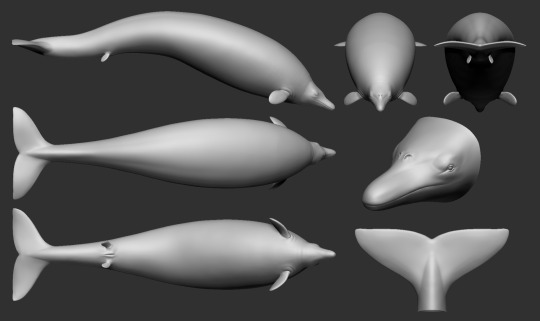
I do not usually post WIPs, but I am happy with this one. The newly described basilosaurid Perucetus colossus (i.e., Chonkocetus the Large), contender for the title of heaviest known animal.
Missing parts (i.e., most of the animal, as customary for fossil vertebrates) based on Basilosaurus spp., Dorudon atrox, modern whales (Neoceti), and sirenians.
#will include proper references in the post for the finished piece#perucetus colossus#perucetus#cetacean#mammal#vertebrate#eocene#cenozoic#paleontology#palaeoblr#paleoart#my art#wip
279 notes
·
View notes
Text
I'm happy to report that this wonderful radiodont fellow finally has a proper name: Echidnacaris briggsi!
Published yesterday - along with the other radiodont from the Emu Bay Shale, now known as Anomalocaris daleyae - in this paper (which is unfortunately not open access, but I'm sure it will get shared somewhere...)
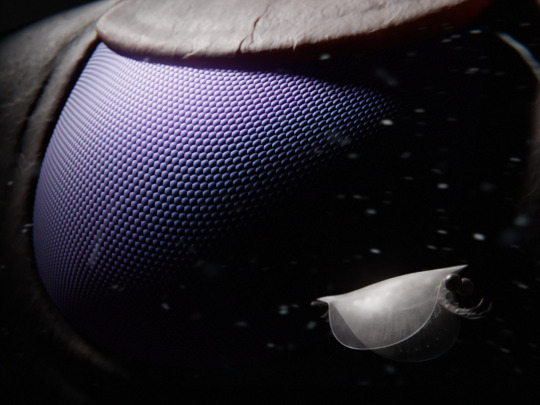
514 millions years ago in what will one day be known as the Emu Bay Shale (South Australia), a tiny Isoxys glaessneri encounters the hunter 'Anomalocaris' briggsi.
'Anomalocaris' briggsi was a large suspension-feeding radiodont related to the famous raptorial predator Anomalocaris canadensis. It is one of two radiodont species for which exceptionally detailed fossils of compound eyes are known. The eyes in this species in this species are unsual for radiodonts in that they are not stalked, and protected by a small plate which was likely a modified version of the lateral carapace elements found in hurdiids. The eye morphology suggests that 'A.' briggsi was a mesopelagic species capable of inhabiting depths of several hundred meters, using its acute vision to detect planktonic prey (Paterson et al. 2020).
Isoxys was a cosmopolitan genus of stem-euarthropod in the Lower and Middle Cambrian, characterized by a bivalved shield covering its whole body, two large eyes, and a frontal pair of so-called 'great appendages' probably used for grasping food items. These appendages show similarity with both the frontal appendages of megacheirans and those of radiodonts like Anomalocaris, and its mix of derived and basal anatomical traits (such as biramous appendages but an unclerotized trunk) make it a crucial organism for understanding the early evolution of arthropods (Legg & Vannier 2013, Zhang et al. 2021).
I tried to recreate the feeling of this common yet lovely type of scene in sci-fi movies where a ship or station gets dwarfed by a gigantic object slowly emerging behind it from the shadows - the only difference is that the 'giant' eye here is only about 3 cm wide, though that was still huge for the time.
References and technical details about the reconstruction under the cut:
The soft parts of I. glaessneri are not known (except for the eyes). Trunk appendages are based on I. curvirostratus (Zhang et al. 2021). Great appendages are partially based on I. communis, which may be the adult form of I. glaessneri (Fu et al. 2012); unfortunately, the great appendages of I. communis are poorly preserved (García-Bellido et al. 2009), so frontal appendage morphology was complemented with the better-known I. acutangulus.
The Isoxys is depicted here with only 11 pairs of trunk limbs, instead of the usual 13+ (Zhang et al. 2021). Based on the assumption that the ancestral arthropod grew by post-hatching addition of segments (anamorphosis) (Liu et al. 2016), a reduced number of trunk limbs was judged appropriate given the small size of the specimen (ca. 6.5 mm) and the possible juvenile nature of I. 'glaessneri'.
References:
Fu, D., Zhang, X., Budd, G. E., Liu, W., & Pan, X. (2014). Ontogeny and dimorphism of Isoxys auritus (Arthropoda) from the Early Cambrian Chengjiang biota, South China. Gondwana Research, 25(3), 975–982. https://doi.org/10.1016/j.gr.2013.06.007
García-Bellido, D. C., Paterson, J. R., Edgecombe, G. D., Jago, J. B., Gehling, J. G., & Lee, M. S. Y. (2009). The bivalved arthropods Isoxys and Tuzoia with soft-part preservation from the Lower Cambrian Emu Bay Shale Lagerstätte (Kangaroo Island, Australia). Palaeontology, 52(6), 1221–1241. https://doi.org/10.1111/j.1475-4983.2009.00914.x
Legg, D. A., & Vannier, J. (2013). The affinities of the cosmopolitan arthropod Isoxys and its implications for the origin of arthropods. Lethaia, 46(4), 540–550. https://doi.org/10.1111/let.12032
Liu, Y., Melzer, R., Haug, J., Haug, C., Briggs, D., Hörnig, M., He, Y., & Hou, X. (2016). Three-dimensionally preserved minute larva of a great-appendage arthropod from the early Cambrian Chengjiang biota. Proceedings of the National Academy of Sciences, 113, 5542–5546. https://doi.org/10.1073/pnas.1522899113
Paterson, J. R., Edgecombe, G. D., & García-Bellido, D. C. (2020). Disparate compound eyes of Cambrian radiodonts reveal their developmental growth mode and diverse visual ecology. Science Advances, 6(49), eabc6721. https://doi.org/10.1126/sciadv.abc6721
Schoenemann, B., & Clarkson, E. N. k. (2011). Eyes and vision in the Chengjiang arthropod Isoxys indicating adaptation to habitat. Lethaia, 44(2), 223–230. https://doi.org/10.1111/j.1502-3931.2010.00239.x
Zhang, C., Liu, Y., Ortega-Hernández, J., Wolfe, J. M., Jin, C., Mai, H., Hou, X. G., Guo, J., & Zhai, D. (2021). Differentiated appendages in Isoxys illuminate origin of arthropodization. Research Square.
#echidnacaris#anomalocaris#anomalocaris daleyae#taxa named after people i know ._.#radiodont#arthropod#emu bay shale#australia#cambrian#paleozoic
487 notes
·
View notes
Text

The orthid brachiopods Nanorthis bifurcata and Lipanorthis santalaurae (attached) from the Early Ordovician of Argentina.
Got inspired by a cool paper I read today and decided to try my hand at 2D art for once. I'm not very good at it but I have to admit it's pretty fun.
Reference:
Santos, A., Mayoral, E., Villas, E., Herrera, Z., & Ortega, G. (2014). First record of Podichnus in orthide brachiopods from the Lower Ordovician (Tremadocian) of NW Argentina and its relation to the early use of an ethological strategy. Palaeogeography, Palaeoclimatology, Palaeoecology, 399, 67–77. https://doi.org/10.1016/j.palaeo.2014.02.003
#nanorthis#lipanorthis#orthid#brachiopod#ordovician#paleozoic#paleontology#palaeoblr#paleoart#my art
40 notes
·
View notes
Text
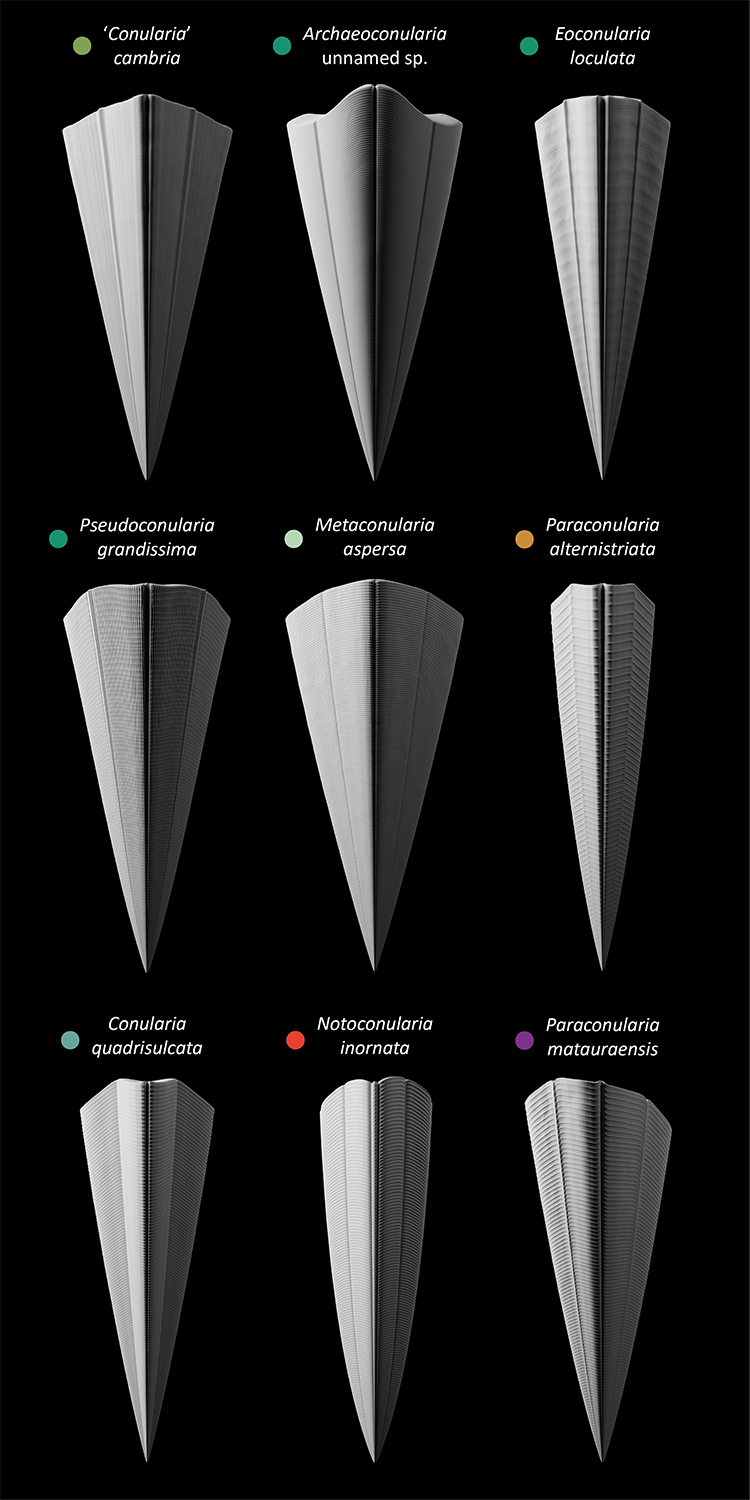
Conulariids are an extinct group of probable cnidarians with 4-sided pyramidal thecae. They are relatively uncommon fossils but ranged from the Cambrian (possibly Ediacaran?) to the Triassic, comprising tens of genera and hundreds of described species (Lucas 2012).
Here are the reconstructed thecae of a small selection of species from every period of the conulariids' range, starting from the Cambrian in the top left and reaching all the way to the Triassic in the bottom right.
Since their soft parts are virtually never preserved (due to them being cnidarians and all that) (Van Iten & Südkamp 2010), most of our knowledge of conulariid biology and evolution is based on their more fossil-friendly thecae, which were composed of thin organophosphatic lamellae (Leme et al. 2008). Live conulariids were attached to the substrate by the apex of their theca; they probably captured suspended food particles or small prey using tentacles, just like other cnidarians, but it's hard to go in any more (non-speculative) detail without preserved soft tissues.
References:
Babcock, L. E. (1986). Devonian and Mississippian conulariids of North America. Part B. Paraconularia, Reticulaconularia, new genus, and organisms rejected from Conulariida. Annals of the Carnegie Museum, 55, 411–479. https://doi.org/10.5962/p.215204
Guimarães Simões, M., Coelho Rodrigues, S., Moraes Leme, J. de, & Van Iten, H. (2003). Some Middle Paleozoic Conulariids (Cnidaria) as Possible Examples of Taphonomic Artifacts. Journal of Taphonomy, 1(3), 163–184.
Hughes, N. C., Gunderson, G. O., & Weedon, M. J. (2000). Late Cambrian Conulariids from Wisconsin and Minnesota. Journal of Paleontology, 74(5), 828–838. https://doi.org/10.1666/0022-3360(2000)074<;0828:LCCFWA>2.0.CO;2
John, D. L., Hughes, N. C., Galaviz, M. I., Gunderson, G. O., & Meyer, R. (2010). Unusually preserved Metaconularia manni (Roy, 1935) from the Silurian of Iowa, and the systematics of the genus. Journal of Paleontology, 84(1), 1–31. https://doi.org/10.1666/09-025.1
Leme, J. M., Simões, M. G., Marques, A. C., & Van Iten, H. (2008). Cladistic Analysis of the Suborder Conulariina Miller and Gurley, 1896 (cnidaria, Scyphozoa; Vendian–Triassic). Palaeontology, 51(3), 649–662. https://doi.org/10.1111/j.1475-4983.2008.00775.x
Lucas, S. (2012). The Extinction of the Conulariids. Geosciences, 2, 1–10. https://doi.org/10.3390/geosciences2010001
Sendino, C., & Zagorsek, K. (2011). The Aperture and Its Closure in an Ordovician Conulariid. Acta Palaeontologica Polonica, 56, 659–663. https://doi.org/10.4202/app.2010.0028
Slater, I. L. (1907). A monograph of British Conulariæ. Printed for the Palæontographical Society.
Thomas, G. A. (1969). Notoconularia, a New Conularid Genus from the Permian of Eastern Australia. Journal of Paleontology, 43(5), 1283–1290.
Van Iten, H., Konate, M., & Moussa, Y. (2008). Conulariids of the Upper Talak Formation (Mississipian, Visean) of Northern Niger (West Africa). Journal of Paleontology, 82(1), 192–196. https://doi.org/10.1666/06-083.1
Van Iten, H., Muir, L., Simões, M. G., Leme, J. M., Marques, A. C., & Yoder, N. (2016). Palaeobiogeography, palaeoecology and evolution of Lower Ordovician conulariids and Sphenothallus (Medusozoa, Cnidaria), with emphasis on the Fezouata Shale of southeastern Morocco. Palaeogeography, Palaeoclimatology, Palaeoecology, 460, 170–178. https://doi.org/10.1016/j.palaeo.2016.03.008
Van Iten, H., & Südkamp, W. H. (2010). Exceptionally preserved conulariids and an edrioasteroid from the Hunsrück Slate (Lower Devonian, SW Germany). Palaeontology, 53(2), 403–414. https://doi.org/10.1111/j.1475-4983.2010.00942.x
Waterhouse, J. B. (1979). Permian and Triassic conulariid species from New Zealand. Journal of the Royal Society of New Zealand, 9(4), 475–489. https://doi.org/10.1080/03036758.1979.10421833
敏郎杉山. (1942). 156. 日本産Conularidaの研究. 日本古生物学會報告・紀事, 1942(25), 185-194_1. https://doi.org/10.14825/prpsj1935.1942.185
#conularia#archaeoconularia#eoconularia#pseudoconularia#metaconularia#paraconularia#notoconularia#conulariid#cnidarian#paleozoic#mesozoic#palaeoblr#paleoart#my art
43 notes
·
View notes
Text
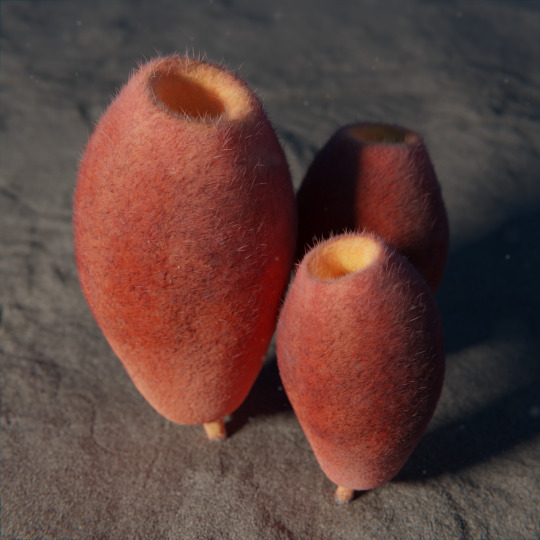
Protomonaxonid sponges standing around (as sponges do) on the enthusiastically bioturbated sediment of the Fezouata Shale, 478 million years ago in the Antarctic Circle.
These early demosponges have been given the rather cumbersome designation of 'Hamptonia' christi Form B, pending a formal description. Standing a few centimeters tall, they (and several other sponges found in Fezouata) formed dense but single-species assemblages interpreted as rapid and repeated colonization events in a hostile environment (Botting 2016).
I could not resist giving them the same coloration as their fossils, which are beautifully rendered in hues of iron oxides. Surely reds and oranges aren't unusual colors for sea sponges?
References:
Botting, J. P. (2016). Diversity and ecology of sponges in the Early Ordovician Fezouata Biota, Morocco. Palaeogeography, Palaeoclimatology, Palaeoecology, 460, 75–86. https://doi.org/10.1016/j.palaeo.2016.05.018
Van Roy, P. (2006). Non-trilobite Arthropods from the Ordovician of Morocco. Gent University.
#hamptonia#protomonaxonid#sponge#fezouata#ordovician#paleozoic#paleontology#palaeoblr#paleoart#my art
113 notes
·
View notes
Text
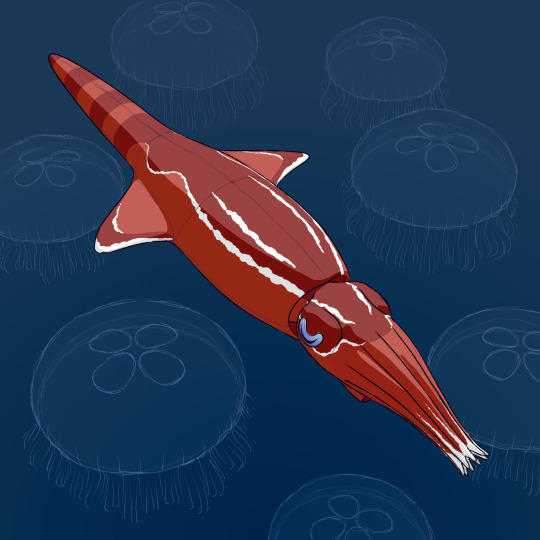
Generic belemnite, surrounded by equally generic Aurelia-type jellyfish.
#mostly modelled from memory so probably not 100% accurate#belemnite#cephalopod#mollusk#aurelia#scyphozoa#cnidarian#jurassic#mesozoic#paleontology#palaeoblr#paleoart#my art
111 notes
·
View notes
Text
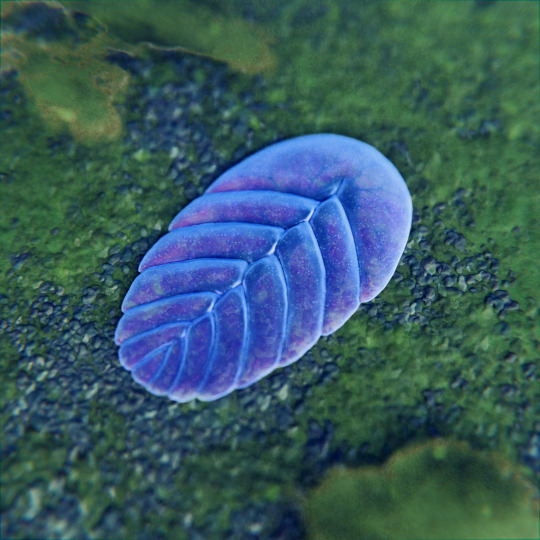
Vendia sokolovi, a 1 cm-long enigmatic* organism from the upper Ediacaran of Russia (displaying the 'glide symmetry' characteristic of many Ediacaran forms), feeding (?) on the bacterial mats that used to be widespread before the Cambrian explosion.
*as Ediacaran organisms tend to be, alas
Some art I made a long time ago but still find kind of neat.
References:
Ivantsov, A. (2001). Vendia and Other Precambrian 'Arthropods'. Paleontological Journal, 35(4), 335-343. https://www.academia.edu/2605872/Vendia_and_Other_Precambrian_Arthropods_
Ivantsov, A. (2004). New Proarticulata from the Vendian of the Arkhangel’sk Region. Paleontological Journal, 38(3), 247–253.
#vendia#proarticulata#ediacaran biota#whatever they are#ediacaran#proterozoic#precambrian#paleontology#palaeoblr#paleoart#my art
410 notes
·
View notes
Text

A shortfin mako shark (Isurus oxyrinchus) I made for an introductory course to ZBrush.
#could be better could be worse#shortfin mako shark#mako shark#shark#isurus#chondrichthyes#vertebrate#holocene#zbrush#my art
40 notes
·
View notes